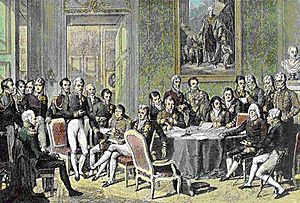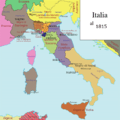Congress of Vienna facts for kids
The Congress of Vienna was a very important meeting of leaders and diplomats from the main countries in Europe. It happened in Vienna, the capital of Austria, from November 1, 1814, to June 8, 1815. The main person in charge was the Austrian statesman Klemens Wenzel von Metternich.
The big goal of this meeting was to decide what Europe would look like after the defeat of Napoleon Bonaparte. It wasn't just one big meeting. Instead, there were many smaller discussions and talks among the most powerful countries.
The Congress aimed to reshape all of Europe after the long Napoleonic Wars. The peace terms with France had already been decided earlier by the Treaty of Paris. The four winning countries first hoped to keep France out of the talks. But a clever French diplomat named Charles-Maurice de Talleyrand-Périgord managed to join the important discussions very quickly.
Contents
Why Was the Congress of Vienna Held?
For many years, Napoleon had changed Europe a lot. He conquered many lands and changed borders. After he was defeated, the leaders of Europe needed to put things back in order. They wanted to create lasting peace and make sure no single country could become too powerful again. This idea was called the "balance of power."
Restoring Peace and Order
The main goal was to bring back stability. Many old rulers had lost their thrones during Napoleon's time. The Congress wanted to restore these rulers. They also wanted to redraw the map of Europe. This would help prevent future wars.
Who Were the Main Players?
The most important countries at the Congress were the "Great Powers." These included Austria, Great Britain, Prussia, and Russia. France, even though it was defeated, also played a key role thanks to Talleyrand.
- Austria: Represented by Prince Klemens Wenzel von Metternich. He was the chairman of the Congress. Metternich wanted to keep things stable and prevent big changes.
- Great Britain: Represented by Viscount Castlereagh. Britain wanted to make sure no country dominated Europe. They also focused on trade and colonial interests.
- Prussia: Represented by Prince Karl August von Hardenberg. Prussia wanted to gain new territories, especially in Germany.
- Russia: Represented by Emperor Alexander I. Russia wanted to expand its influence in Europe.
- France: Represented by Charles-Maurice de Talleyrand-Périgord. He was very skilled. He helped France be seen as a victim of Napoleon, not just a defeated enemy. This allowed France to have a say in the new Europe.
What Did the Congress Decide?
The Congress made many important decisions that shaped Europe for almost 100 years. They redrew borders, created new countries, and brought back old rulers.
Redrawing the Map of Europe
Many borders were changed. For example:
- France lost the lands it had gained under Napoleon.
- A new Kingdom of the Netherlands was created. It combined the Dutch Republic and the Austrian Netherlands (modern-day Belgium).
- Prussia gained new territories in Germany.
- Russia gained more control over Poland.
- Austria gained lands in Italy.
- The German states were organized into a loose group called the German Confederation.
The Idea of Balance of Power
The leaders at Vienna wanted to create a "balance of power." This meant making sure no one country was strong enough to threaten others. They hoped this would prevent another major war like the Napoleonic Wars. They also created a system where the Great Powers would meet regularly to discuss issues. This was called the "Concert of Europe."
Lasting Impact
The Congress of Vienna was very successful in creating a long period of peace in Europe. There were no major wars involving all of Europe for almost 40 years after the Congress. It showed how countries could work together to solve big problems. However, some of its decisions also led to future problems. For example, some groups of people who shared a language or culture were split across different countries. This later led to nationalist movements.
Images for kids
-
Talleyrand proved an able negotiator for the defeated French.
See also
 In Spanish: Congreso de Viena para niños
In Spanish: Congreso de Viena para niños






